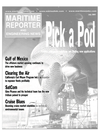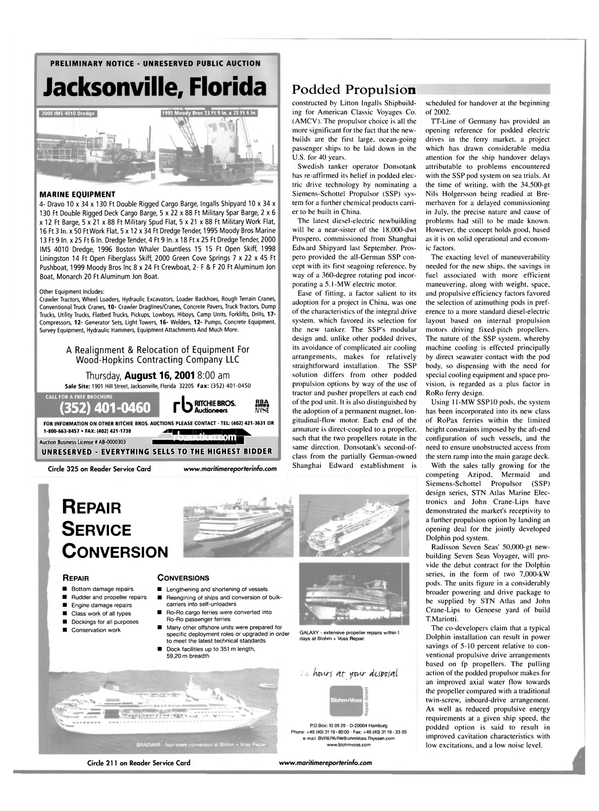
New Technology Debuts in Oslo
NorShipping 2001, held in Oslo, Nor- way in early June, once again proved to be a dynamic exhibition complete with some of the more influential personnel in the marine business on-hand for the week long event. As usual, marine man- ufacturers used the platform of NorShip- ping to launch new products, systems and services to the international market, some of which is detailed in the following report.
Wartsila Corp., the ubiquitous propulsion system manufacturer announced that it had received a contact to supply the complete marine power system for the first of a series of environmentally safe 40,000-dwt chemical/ product tankers building at the San Marco shipyard in Italy. In an interview with Wartsila's Mikael Makinen earlier this year, he stressed that the company was expanding beyond the mere business of manufacturing engines, seeking to become a single source propulsion system provider, or, as the company touts, "The Ship Power Supplier." For the 40,000-dwt tankers, Wartsila will be just that, as it is responsible for the complete functionality of the system.
In addition to supplying the hardware, it will provide the shipyard with all of the functional drawings and will be supervising the plant's installation, commissioning and sea trials. The ship will be equipped with a Wartsila 6L64 medium-speed diesel engine, of 12,060 kW output at 333 rpm and a CP 6,200 mm diameter Lips propeller, together with shafting and reduction gear. The new vessel will measure 563 ft. (171.6 m) long and feature 12 cargo, two slop and one recovery tank. The propulsion package will give the ship a maximum 17-knot speed on a 34 ft. (10.3 m) draft, and a service speed of 16 knots.
Leica made waves on the electronics front by introducing first fully integrated GPS/DGPS/AIS shipboard system.
While the final standards regarding AIS are still years in the making, Leica — traditionally a company that pushes the innovation edge — has delivered a product in the MX 420, which incorporates a high-accuracy MX 421 GPS/DGPS receiver and an IMO-compliant AIS transponder system, with a combined control and display unit. Optionally, the MX 420 AIS can be interfaced with an already installed GPS or DGPS receiver onboard instead of the MX 421. The AIS transponder module in the MX 420 system was designed and developed by SAAB TransponderTech, and meets all specifications for marine AIS shipboard equipment, and is designed to be compliant with future standards through software upgrades. The combined system takes advantage of another Leica innovation, the MX 421, a typeapproved high-precision GPS/DGPS "smart antenna." It was the first GPS product to use the new Silicon Germanium (SiGe) receiver chip, and was developed jointly by Leica and IBM.
In the wake of corporate consolidations, marine buyers can sometimes be confused as from which house comes which product. ExxonMobil, which completed the granddaddy of all mergers last year in combining the two oil industry behemoths, announced a plan to simplify the marine lubricants buying choice to its deep sea customers. ExxonMobil Marine Lubricants announced that its Mobilgard brand will be the flagship product line offered to deep sea customers. The Mobilgard brand includes a full range of mineral oils and synthetic lubricants for marine engines and equipment.
The company will retain the Esso and Exxon brand of marine lubricants for the coastal and inland sectors.
The company also introduced an enhanced oil analysis program with new Web-based delivery capabilities.
Dubbed Signum Oil Analysis, it will replace the company's Exxcare and Progressive Fast Analysis (PFA) oil analysis programs. "The upgraded Exxcare and PFA programs adds new on-line capabilities that will make it easier for customers to access information and remedy problems," said Wayne Sirois, global marketing manager, ExxonMobil Marine Lubricants.
The new system allows customers to gain access to their specific accounting information, including online lube charts, through the Internet, without adding new software.
Transas Marine, another company synonymous with advanced marine technology, in June launched the first of its new generation Navi-Sailor navigation systems, Navi-Sailor 3000. The system incorporates all the functionality of the previously type-approved ECDIS with an additional array of innovative features.
According to Peter Mantel, director of marketing and business development, Transas made the decision about a year and a half ago to invest in a new platform that would satisfy the technological needs of today and tomorrow. The system has been designed with flexibility in mind, as it features: the option of North- Up/Course- U p / H e a d - U p chart display modes; integrated weather forecasting, multiple chart display and user-selectable screen layout; advanced Route Planning, Radar Overlay and Playback facilities; Relative and True Motion display; and an advanced (U)AIS transponder interface, that will be modified with the final specification come out. The company intends to launch two additional products in the series later this year.
Hamworthy KSE AB, the Swedish-based dry cargo handling division of Hamworthy KSE, stressed that it was involved in far more than the simple design, manufacture and supply of cargo handling solutions. The organization is involved with three major European shipping transport projects, including the Improved Port Ship Interface (IPSI) project, which aims to reduce cargo transported on Europe's clogged motorways with an integrated solution highlighting short sea shipping and inland waterways transportation.
Other significant developments that occurred throughout the week included: MacGregor announced that its new Sherlog ultrasonic testing system — designed to quickly and easily check the cargo access sealing system — has been type approved.
Lloyd's Register completed a studyto find the optimum solution to the question of how to most efficiently propel the next generation of Ultra Large Containerships (UCLS).
Finland's Loipart introduced a combined fire resistant and thermally insulated door for cold rooms and freezers, the A-60 line.
Read New Technology Debuts in Oslo in Pdf, Flash or Html5 edition of July 2001 Maritime Reporter
Other stories from July 2001 issue
Content
- MariTel Launches New Marine Telephone Service With Vessel Location page: 36B
- Repowering and Niche Marketing at Westar page: 36D
- Hybrid Powering for Boxships page: 8
- Largest Spanish RoPax Enters Service page: 12
- MarineSoup.com Creates Online Marketplace page: 13
- Bollinger Christens 8,000-hp Towboat, Bootsie B page: 14
- COMSAT Mobile Honored For Maritime Safety page: 15
- USN Awards $52M Contract To DD21 Gold Team page: 16
- Aegis Destroyer Christened At Ingalls Shipbuilding page: 19
- Marco Shipyard Concludes Pilot Station Vessel Contract page: 20
- Kockum Sonics AB launches Ballast Water Exchange Concept page: 21
- Carnival's 2Q Earnings Drop Eight Percent page: 22
- Mechanical Problems, Late Deliveries Continue to Plague Industry page: 23
- Local Yards Start To Feel The Impact page: 26
- Owners... Start Counting The Cash page: 29
- Back in Business — Iridium Returns Under New Ownership page: 33
- Xantic: New Look, New Name... More Service page: 36
- Podded Propulsion Goes Beyond the Cruise Realm page: 44
- Forging Ahead page: 51
- Deerberg Systems: Experts in Flow Management page: 55
- New Technology Debuts in Oslo page: 56
- Brunvoll Bucks The Trend, And Prospers page: 57


